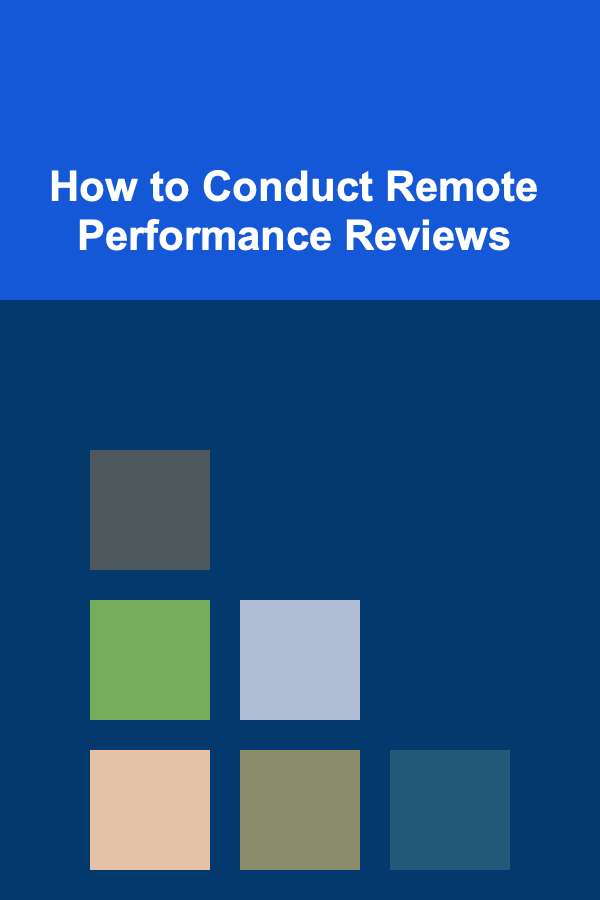
How to Conduct Remote Performance Reviews
ebook include PDF & Audio bundle (Micro Guide)
$12.99$11.99
Limited Time Offer! Order within the next:

The shift to remote work has transformed many aspects of the traditional workplace, and one of the areas most significantly impacted is performance reviews. The remote environment offers a unique set of challenges and opportunities when it comes to evaluating and providing feedback to employees. Conducting remote performance reviews effectively requires adapting to new tools, communication strategies, and techniques to ensure employees receive constructive feedback that helps them grow, even in a virtual setting.
In this article, we will explore how to conduct remote performance reviews, providing a step-by-step guide to ensure they are not only efficient but also meaningful for both managers and employees.
Understanding the Importance of Remote Performance Reviews
Before diving into how to conduct performance reviews, it's important to understand why they matter. Performance reviews provide employees with essential feedback on their work and development, allowing them to see where they excel and where they may need improvement. For managers, performance reviews help in making informed decisions about promotions, compensation, training needs, and future projects.
In a remote setting, this process can become more complicated. The lack of in-person interactions and physical cues might make it harder to gauge an employee's performance, mood, and engagement levels. Moreover, the absence of direct observation could lead to biases, misunderstandings, or gaps in feedback. As a result, conducting remote performance reviews requires deliberate effort to ensure clarity, fairness, and constructive engagement.
Prepare Thoroughly for the Review
The first step in conducting a meaningful remote performance review is preparation. Thorough preparation allows you to gather all necessary data and insights to offer a well-rounded review.
2.1. Collect Feedback from Multiple Sources
In remote environments, managers often have fewer opportunities for day-to-day interaction with their team members, so gathering comprehensive feedback from multiple sources is key. This can include:
- Peer Feedback: Remote workers often collaborate with various team members. Collecting feedback from colleagues provides insights into how an employee interacts with others, handles tasks, and contributes to team goals.
- Self-Assessments: Encouraging employees to conduct self-assessments allows them to reflect on their own work and identify areas where they feel they have grown or need improvement.
- Client or Customer Feedback: If applicable, gathering feedback from clients or customers helps evaluate the employee's performance in serving external stakeholders.
- Data Analytics: For certain roles, you may have access to performance metrics that can help quantify aspects of performance. For example, sales numbers, completed projects, or customer satisfaction scores can provide tangible evidence of an employee's success.
2.2. Reflect on the Employee's Goals and Objectives
Before conducting a review, revisit the goals set during the previous review cycle or at the start of the review period. These objectives serve as a benchmark for evaluating performance. Assess whether the employee has met, exceeded, or fallen short of these goals. Take note of any significant achievements or challenges that occurred during the review period.
2.3. Prepare Specific Examples
In remote performance reviews, it's important to back up feedback with specific examples. Citing concrete instances of how an employee excelled or encountered challenges helps them better understand the rationale behind the feedback. This is especially crucial in a remote setting, where employees may not have had regular face-to-face check-ins to understand their strengths and areas for improvement.
Choose the Right Technology for the Review
In a remote work environment, the tools you use to conduct the performance review play a pivotal role in its effectiveness. Choosing the right technology will ensure smooth communication, easy document sharing, and clear discussions.
3.1. Video Conferencing Platforms
Video calls are essential for remote performance reviews. While phone calls or text-based communication can work in some situations, video conferencing enables real-time face-to-face interactions that help convey tone, emotion, and empathy. Platforms like Zoom, Microsoft Teams, or Google Meet are commonly used for remote performance reviews, offering features such as screen sharing and virtual whiteboards.
3.2. Collaboration Tools
Collaboration tools, such as Slack, Asana, or Trello, can be used to track the progress of objectives and projects over time. These tools allow you to revisit the employee's performance and the feedback they received throughout the review period. Sharing documents or feedback in real-time during the meeting can also be facilitated through these tools.
3.3. Document Sharing and Feedback Platforms
Many performance reviews require tracking goals and providing formal written feedback. Google Docs, Microsoft Word, or dedicated performance management systems such as Lattice or BambooHR can facilitate this. These platforms allow for collaborative documentation of goals, achievements, and feedback. It also makes it easier for employees to access and reflect on the feedback provided.
Set the Right Environment for the Review
While the performance review process is virtual, you should strive to replicate the quality of interaction one might have in an in-person setting. This begins with setting the right environment for the review.
4.1. Schedule the Review in Advance
Given the time zone differences and the busy schedules in remote teams, scheduling the review well in advance is crucial. Allow both yourself and the employee sufficient time to prepare, and be sure to allocate enough time for the review. A typical performance review should last between 30 minutes and an hour.
4.2. Create a Comfortable and Private Space
Both you and the employee should have a quiet, private space for the review. In a remote setting, it's easy for distractions to arise, so it's essential to have an environment where both parties can focus. Ensure that there are no interruptions, and encourage the employee to do the same. A stable internet connection and a professional video setup are also important for reducing technical issues.
4.3. Set the Tone for a Constructive Conversation
The tone of the conversation is vital in remote performance reviews. You should aim to make the review a two-way discussion rather than a one-sided evaluation. Encourage openness and transparency, so employees feel comfortable sharing their thoughts and concerns. Also, ensure that feedback is constructive and balanced, focusing on both strengths and areas for improvement.
Structure the Review Meeting Effectively
A well-structured performance review helps ensure that both the manager and the employee stay on track and cover all relevant topics. The meeting should be organized but flexible enough to accommodate an open discussion.
5.1. Begin with Positive Feedback
Start the review by acknowledging the employee's successes and positive contributions. When employees feel appreciated and recognized for their efforts, it sets a positive tone for the rest of the conversation. Focus on specific achievements and how they have impacted the team or company.
5.2. Discuss Challenges and Areas for Improvement
After discussing the positive aspects, it's time to address areas for improvement. Be specific and offer actionable suggestions. Avoid vague statements like "You need to communicate better" or "You should be more proactive." Instead, focus on particular instances where improvement is needed and provide guidance on how the employee can address those challenges.
5.3. Solicit Feedback from the Employee
The performance review should be a two-way conversation. Encourage the employee to provide feedback on their experience in their role, any obstacles they may be facing, and their thoughts on the team and company. It's essential to listen actively and be open to receiving feedback, as this can provide valuable insights into how to support the employee better in the future.
5.4. Set Goals and Development Plans
Setting clear goals for the next review cycle is a crucial part of the performance review process. These goals should be specific, measurable, achievable, relevant, and time-bound (SMART). Additionally, discuss any professional development opportunities, such as training, mentorship, or projects that will help the employee grow in their role.
5.5. End on a Positive Note
Conclude the review by reiterating your appreciation for the employee's hard work. End the conversation on an optimistic and motivating note, reinforcing the potential for growth and future success. This will help maintain the employee's morale and keep them engaged moving forward.
Provide Ongoing Feedback and Follow-Up
Remote performance reviews should not be a one-time event. Providing ongoing feedback throughout the year ensures that employees are aware of their progress and any adjustments they need to make. Regular check-ins help prevent surprises during formal performance reviews and create a more continuous feedback loop.
6.1. Regular One-on-One Meetings
Schedule regular one-on-one meetings with employees, whether weekly or bi-weekly. These meetings offer a chance to check in on progress, discuss any challenges, and provide support.
6.2. Continuous Feedback
Instead of waiting for annual or semi-annual reviews, offer feedback on a more consistent basis. This helps employees address issues as they arise and gives them more opportunities to improve throughout the year. Continuous feedback fosters a growth mindset and improves overall team performance.
6.3. Follow-Up on Development Plans
After setting goals and development plans during the review, follow up periodically to track progress. Check in on specific milestones, and provide additional guidance or resources as needed. Offering support as the employee works towards their goals helps ensure success.
Conclusion
Conducting remote performance reviews requires intentionality, preparation, and the right tools to ensure the process is meaningful and constructive. By following these guidelines, you can create a positive experience for both you and your remote team members, fostering a culture of continuous improvement, growth, and engagement. By effectively leveraging technology, structuring the review appropriately, and offering consistent feedback, remote performance reviews can be a valuable tool in helping employees succeed and thrive in a virtual environment.

How to Create a DIY Family Art Gallery at Home
Read More
How to Design a Functional Laundry Area
Read More
How to Maintain a Staged Home During Showings
Read More
How to Organize Your Child's Homework Station
Read More
How to Renovate Your Home's Lighting for a Modern Look
Read More
How To Engage in Wildlife Rehabilitation Volunteering
Read MoreOther Products

How to Create a DIY Family Art Gallery at Home
Read More
How to Design a Functional Laundry Area
Read More
How to Maintain a Staged Home During Showings
Read More
How to Organize Your Child's Homework Station
Read More
How to Renovate Your Home's Lighting for a Modern Look
Read More